Input interpretation

isoamyl alcohol
Chemical names and formulas

formula | (CH_3)_2CHCH_2CH_2OH Hill formula | C_5H_12O name | isoamyl alcohol IUPAC name | 3-methylbutan-1-ol alternate names | 1-butanol, 3-methyl- | 3-methyl-1-butanol | 3-methylbutan-1-ol | isopentanol | isopentyl alcohol mass fractions | C (carbon) 68.1% | H (hydrogen) 13.7% | O (oxygen) 18.1%
Lewis structure
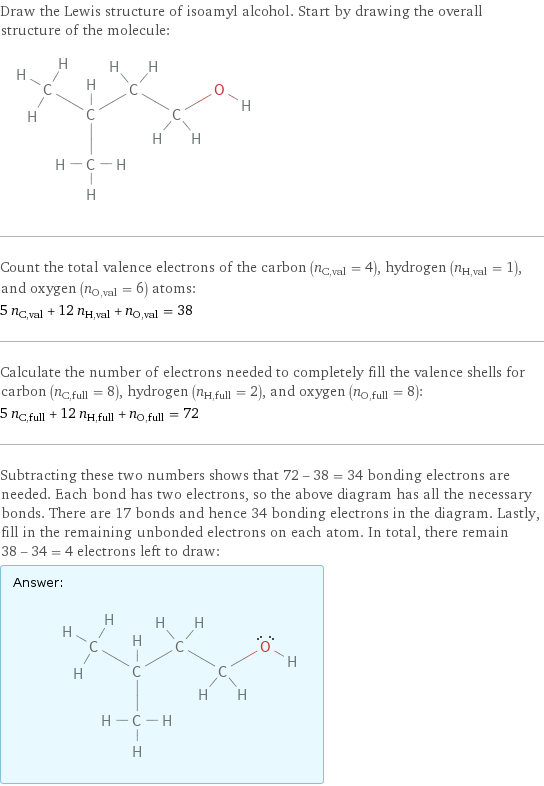
Draw the Lewis structure of isoamyl alcohol. Start by drawing the overall structure of the molecule: Count the total valence electrons of the carbon (n_C, val = 4), hydrogen (n_H, val = 1), and oxygen (n_O, val = 6) atoms: 5 n_C, val + 12 n_H, val + n_O, val = 38 Calculate the number of electrons needed to completely fill the valence shells for carbon (n_C, full = 8), hydrogen (n_H, full = 2), and oxygen (n_O, full = 8): 5 n_C, full + 12 n_H, full + n_O, full = 72 Subtracting these two numbers shows that 72 - 38 = 34 bonding electrons are needed. Each bond has two electrons, so the above diagram has all the necessary bonds. There are 17 bonds and hence 34 bonding electrons in the diagram. Lastly, fill in the remaining unbonded electrons on each atom. In total, there remain 38 - 34 = 4 electrons left to draw: Answer: | |
3D structure
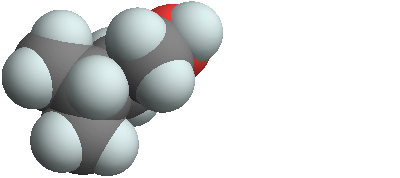
3D structure
Basic properties
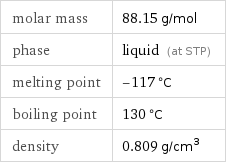
molar mass | 88.15 g/mol phase | liquid (at STP) melting point | -117 °C boiling point | 130 °C density | 0.809 g/cm^3
Units

Hydrophobicity and permeability properties

predicted LogP hydrophobicity | 1.33 predicted LogS | -0.37
Basic drug properties

approval status | experimental | small molecule
Liquid properties (at STP)
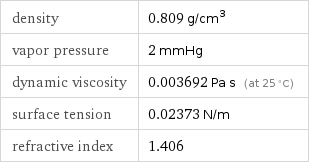
density | 0.809 g/cm^3 vapor pressure | 2 mmHg dynamic viscosity | 0.003692 Pa s (at 25 °C) surface tension | 0.02373 N/m refractive index | 1.406
Units

Thermodynamic properties

specific heat of formation Δ_fH° | gas | -3.411 kJ/g molar heat of formation Δ_fH° | gas | -300.7 kJ/mol molar heat of vaporization | 44.23 kJ/mol | specific heat of vaporization | 0.5018 kJ/g | molar heat of combustion | 3415 kJ/mol | specific heat of combustion | 38.74 kJ/g | critical temperature | 577 K | critical pressure | 3.93 MPa | (at STP)
Chemical identifiers
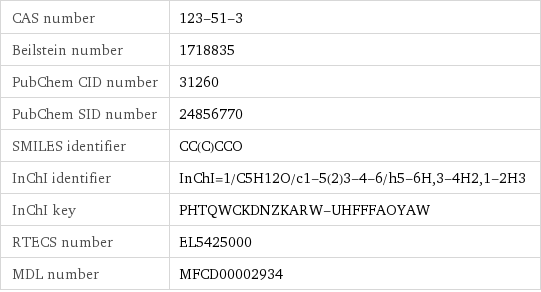
CAS number | 123-51-3 Beilstein number | 1718835 PubChem CID number | 31260 PubChem SID number | 24856770 SMILES identifier | CC(C)CCO InChI identifier | InChI=1/C5H12O/c1-5(2)3-4-6/h5-6H, 3-4H2, 1-2H3 InChI key | PHTQWCKDNZKARW-UHFFFAOYAW RTECS number | EL5425000 MDL number | MFCD00002934
NFPA label

NFPA label
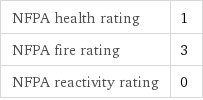
NFPA health rating | 1 NFPA fire rating | 3 NFPA reactivity rating | 0
Safety properties
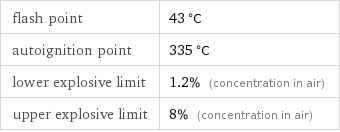
flash point | 43 °C autoignition point | 335 °C lower explosive limit | 1.2% (concentration in air) upper explosive limit | 8% (concentration in air)

DOT hazard class | 3 DOT numbers | 1105
Toxicity properties

threshold limit value | 100 ppmv

RTECS classes | tumorigen | human data | primary irritant